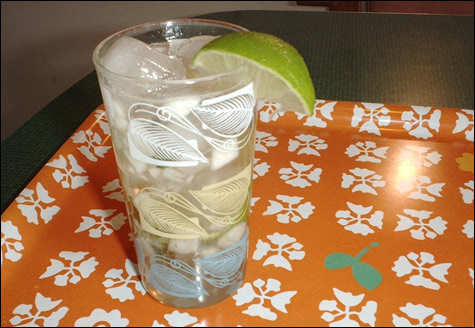
READY FOR CONSUMPTION: Gin with cucumber! |
Gin has a massive public-relations problem, one that is centuries old and showing no signs of waning. Despite multi-million-dollar ad campaigns attempting to give action to gin drinking (e.g., the verb "to Tanqueray") the general populace is still fearful of this action and its potential effects on your night and morning-after. Really, gin is nothing to be feared. Sure, everyone knows at least one of the classic gin cocktails (like the Negroni, the Singapore Sling, and Pimm's Cup), but there are several others that are slightly simpler and ready to help you usher in warmer weather.Gin takes its name from genever, the Dutch word for juniper, which is gin's primary flavor ingredient. In addition to these little berries, gin also contains several different botanicals, a mixture of herbs, flowers, fruits, and spices whose recipe is closely guarded by each distiller. It first appeared on the shelves of apothecaries, and was used to combat all sorts of unfamiliar (and likely unable to diagnose) ailments such as gout and lumbago. (Perhaps patients just claimed to suffer these maladies, with a gin cure in mind?) And I have an Irish friend who insists that his grandmother used gin as an aftershave.
By the time gin reached England, though, its consumption had become an epidemic, thanks to the inexpensiveness of the ingredients and deregulation of home distilling. It was at this point that gin became the unwelcome guest, and was blamed for medical misery and rampant alcoholism all over Europe.
It was left to the British Navy to resurrect the idea that gin had value and purpose. At the height of British colonialism in warmer climates, the gin and tonic was born to provide the necessary dose of quinine to combat malaria. Add a generous amount of lime, and you combat scurvy as well, with one twist of the wrist.
And then, there's martini man Bond, James Bond. In the pages of Casino Royale, Bond scribe Ian Fleming, a former British Navy man himself, pens a prescription for Bond that is heavy on the gin, with a dash of vodka. Of note here is that the accompaniment is not the more likely vermouth and olives, but Lillet, a quinine-flavored aperitif, and lemon peel.
To bring this age-old spirit into modern times, forgo the often-expensive aperitifs and cordials for mixers, and go for simple and easy elements. Cucumber might seem an odd ingredient for, but it has appeared on the guarded lists of botanicals many times before. Trim the ends, skin, and seeds from the cucumber, leaving only the "meat." Dice and place a few tablespoons full into a highball glass with a small handful of mint leaves, a dusting of sugar, and a lime wedge. Muddle with a wooden spoon until sufficiently beaten up, mojito-style, then add ice and a generous measure of gin. Top with club soda and you have one of the simplest, most refreshing drinks ever.
Also keeping company in this club is the Salty Dog. Salt the rim of a highball glass and fill it with ice. Pour in your measure of gin and top with freshly squeezed grapefruit juice. This combination is memorably exquisite.
The pièce de résistance, though, is a killer martini made with a quick-infused Earl Grey gin. This quintessentially British drink is made by dunking Earl Grey teabags into a bottle of your favorite gin, if you have one, and letting it steep. Room temperature will get the job done quickly, but it is not unreasonable to put this preparation in the freezer overnight. Don't squeeze the teabags — that will just impart a bitter note. Shake your infused gin with a squeeze of lemon and simple syrup, and serve. Or, alternately, make a "dry" preparation with no sweetener and an orange peel garnish.
Todd Richard can be reached at tmr@maine.rr.com.